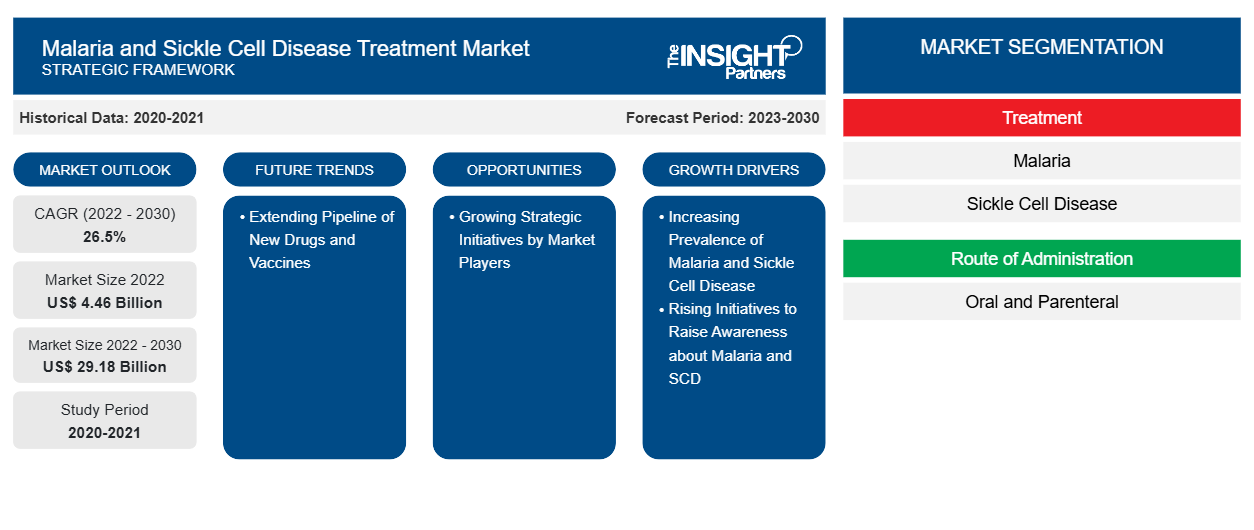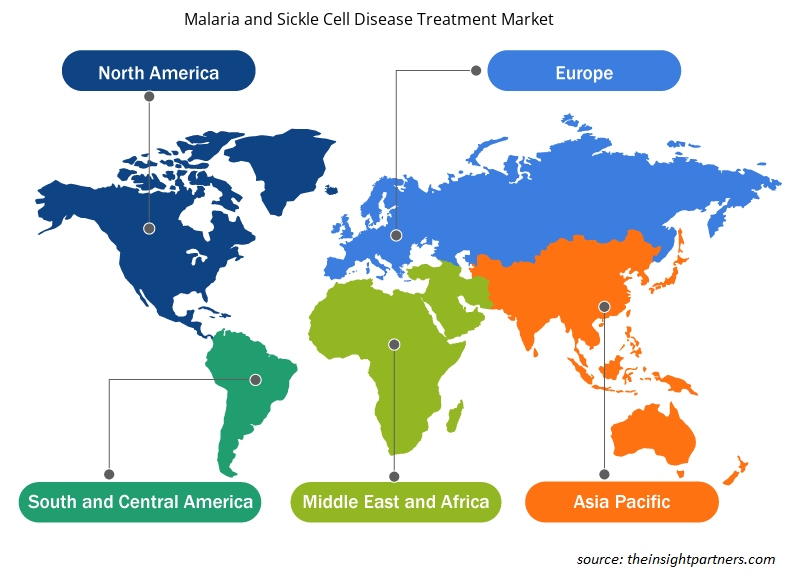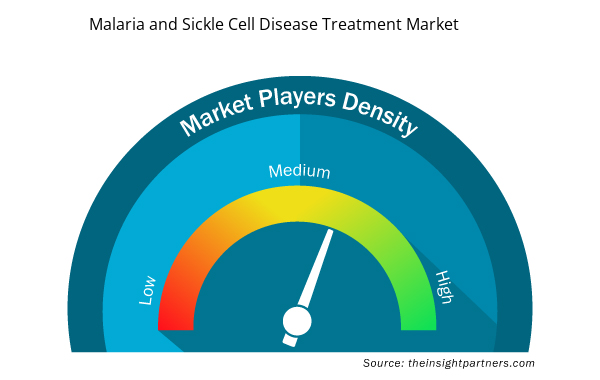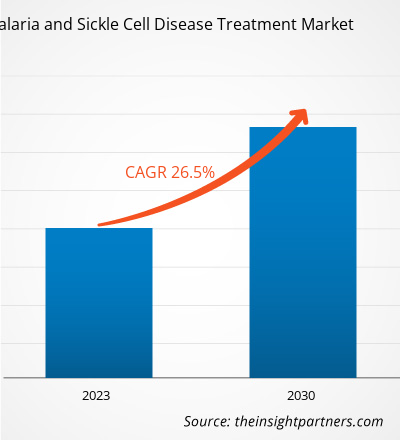[Research Report] The malaria and sickle cell disease treatment market size was valued at US$ 4,457.15 million in 2022 and is projected to reach US$ 29,179.60 million by 2030; it is estimated to record a CAGR of 26.5% from 2022 to 2030.
Market Insights and Analyst View:
A parasite belonging to the Plasmodium genus causes malaria, a potentially fatal illness. The bite of a female Anopheles mosquito transmits this parasite. It can also be found in some regions of Southeast Asia, Central & South America, and sub-Saharan Africa, where malaria is most likely to occur. Although five Plasmodium species can infect people, Plasmodium falciparum (P. falciparum) and Plasmodium vivax (P. vivax) are the most common causes of malarial illnesses. Certain red blood cell abnormalities have changed throughout time to lessen the severity of malaria. Sickle cell trait is one of these red blood cell diseases, where a person generates both normal and aberrant hemoglobin.
Growth Drivers:
Malaria, one of the acute febrile illnesses, is caused by plasmodium parasites and spreads through the infected female Anopheles mosquitoes. Five parasite species in humans mainly cause malaria, and two of these species—Plasmodium falciparum and P. vivax—are considered the greatest threat to human health. Also, P. falciparum is the deadliest malarial parasite, and it is most widely spread across the African continent. Further, P. vivax is the dominant malarial parasite in most countries outside of sub-Saharan Africa. According to the latest World Malaria Report (WMR) 2020 from the World Health Organization (WHO), 241 million cases of malaria were reported in the world, in comparison to 227 million cases that were logged in 2019. According to the same source, the number of deaths caused due to malaria has an annual rise of 69,000. Approximately two-thirds of these deaths, i.e., 47,000, were caused by disruptions in healthcare services during the COVID-19 outbreak; the remaining one-third of deaths, i.e., 22,000 reflected a recent change in the WHO’s methodology for calculating malaria mortality (irrespective of COVID-19 disruptions).
The WHO African region accounted for a high share of the global burden of malaria. In 2020, ~95% of global cases and ~96% of deaths were reported in Africa due to malaria, and ~80% of the total deaths that were reported were in children aged 5 and below. According to the WHO, four African countries, Nigeria, Tanzania, the Democratic Republic of the Congo, and Mozambique, recorded approximately half of all malaria-related deaths that were reported globally. According to the LANCET Regional Health 2020, African countries had the highest burden of malaria; P. falciparum is a notable cause of the highest mortality rates in children younger than 5, which accounts for ∼77% across the world; in African countries, P. falciparum accounts for ∼96% of total mortalities caused among children by malaria. P. vivax has been a causal agent of 2% (4.5 million) of the total cases of malaria, mainly from Asia. According to WMR 2021, ∼2% of the global burden of malaria was recorded by Southeast Asian countries, where India accounted for 83% of estimated malaria cases and 82% of deaths associated with malaria in 2020.
The treatment plan for sickle cell disease (SCD) can be divided into two categories: maintaining health and treating complications. Sickle cell anemia has genotypic and phenotypic variants that are based on unique mutations in hemoglobin genes. There is a high prevalence of the disease as well as a rise in its severity across the globe. According to the WHO, approximately 5% of the world's population has genes inhibiting hemoglobin diseases such as sickle cell anemia and thalassemia. According to a study on sickle cell disease published in the National Library of Medicine, more than 300,000 babies are born with severe hemoglobin disorders each year; also, 400,000 newborns are expected to have sickle cell disease by 2050. In addition, according to a published report in 2023 by the American Society of Hematology, the estimated number of people suffering from SCD in the US is approximately 70,000–100,000. Thus, the rising prevalence of malaria and sickle cell disease in different regions across the globe boosts the malaria and sickle cell disease treatment market growth.
Customize This Report To Suit Your Requirement
You will get customization on any report - free of charge - including parts of this report, or country-level analysis, Excel Data pack, as well as avail great offers and discounts for start-ups & universities
Malaria and Sickle Cell Disease Treatment Market: Strategic Insights

- Get Top Key Market Trends of this report.This FREE sample will include data analysis, ranging from market trends to estimates and forecasts.
Customize This Report To Suit Your Requirement
You will get customization on any report - free of charge - including parts of this report, or country-level analysis, Excel Data pack, as well as avail great offers and discounts for start-ups & universities
Malaria and Sickle Cell Disease Treatment Market: Strategic Insights

- Get Top Key Market Trends of this report.This FREE sample will include data analysis, ranging from market trends to estimates and forecasts.
Report Segmentation and Scope:
The malaria and sickle cell disease treatment market is segmented on the basis of treatment, route of administration, distribution channel, and geography. Based on treatment, the market is divided into malaria and sickle cell disease. In terms of route of administration, the malaria and sickle cell disease treatment market is divided into oral and parenteral. Based on distribution channel, the market is categorized into direct tender, hospital pharmacies, retail pharmacies, online pharmacies, and others. The malaria and sickle cell disease treatment market, based on geography, is segmented into North America (US, Canada, and Mexico), Europe (Germany, France, Italy, UK, Spain, and Rest of Europe), Asia Pacific (Australia, China, Japan, India, South Korea, and Rest of Asia Pacific), Middle East & Africa (UAE, Saudi Arabia, Africa, Nigeria, Congo, Tanzania, Uganda, Ghana, Kenya, Zambia, and the Rest of Middle East & Africa), and South & Central America (Brazil, Argentina, and Rest of South & Central America).
Segmental Analysis:
The malaria and sickle cell disease treatment market, by treatment, is divided into malaria and sickle cell disease. In 2022, the malaria segment held a larger market share, and the same segment is estimated to grow at a CAGR of 28.5% from 2022 to 2030. The parasite Plasmodium falciparum predominantly causes malaria. Malaria cannot spread directly from person to person; only an infected mosquito bite can transfer the parasite that enters the bloodstream and travels to the liver. Chloroquine (also called chloroquine phosphate) is an antimalarial drug available in the US by prescription only and is sold under the brand name Aralen, and it is also a generic medicine. Quinine, isolated from the Cinchona bark in 1820, was the first identified antimalarial drug. WHO recommends the RTS, S/AS01 (RTS, S) malaria vaccine to prevent malaria in children. Results from the ongoing pilot program in Ghana, Kenya, and Malawi informed the recommendation for the first malaria vaccine. Four years after the pilots, ~1.5 million children have been reached with their first dose of malaria vaccine since 2019.
By route of administration, the malaria and sickle cell disease treatment market is bifurcated into oral and parenteral. In 2022, the oral segment held a larger market share, and the parenteral segment is estimated to record a faster CAGR during the forecast period. Oral drug delivery is the most ideal and suitable route of drug administration as it offers high patient compliance, non-invasiveness, least sterility constraints, cost-effectiveness, flexibility in the design of dosage form, and ease in the manufacturing process. Benefits such as ease of administration and long-term cost efficiency are the major factors fueling the adoption of oral drugs. Low manufacturing cost of capsules, tablets, and other orally administered drugs propel the malaria and sickle cell disease treatment market growth. A few of the available anti-malarial drugs are quinine, quinidine, chloroquine, amodiaquine, tafenoquine proguanil, chlorproguanil, and artemisinin. The Artemisinin-based combination treatments (ACTs) and the combination therapies are being used for treating uncomplicated malaria caused by the P. falciparum parasite. ACTs are the most effective antimalarial medicines currently available in the market.
Based on distribution channel, the malaria and sickle cell disease treatment market is segmented into direct tender, hospital pharmacies, retail pharmacies, online pharmacies, and others. The direct tender segment held the largest market share in 2022. A tender is an offer to do specific duties or provide items for a fixed amount. In the first step of a tender procedure, contractors will be asked to submit sealed bids for construction or to offer particularly planned services or products within a specific time limit. The e-tendering procedure in India is designed to ensure that work for the government or a specific client is completed in a timely manner. Some places, for example, may have specific procurement regulations that dictate how decisions are made and which tenders are accepted. For instance, the All India Institute of Medical Sciences (AIIMS) invites bids from experienced, reputed, and financially sound companies, agencies, and firms for malaria testing kits and drugs from different healthcare facilities in India. Those who have been in a similar business for the last three years and providing the same service to central/state government/reputed private hospitals or autonomous bodies may send their technical and commercial bids in sealed envelopes.
Regional Analysis:
Based on geography, the malaria and sickle cell disease treatment market is categorized into five key regions—North America, Europe, Asia Pacific, South & Central America, and the Middle East & Africa. North America captured a significant share of the global market in 2022. According to the Centers for Disease Control and Prevention (CDC), approximately 2,000 cases of malaria are reported annually in the US, mostly in travelers from other countries and immigrants. Pregnant women and children under 5 years of age are at the highest risk of contracting malaria and developing severe diseases. There is a perpetual risk that malaria transmission can resume in the US due to the endurance of anopheles mosquitoes (vectors) capable of transmitting malaria in the US.
According to the Global Fund data from April 2022, cases and deaths related to malaria grew mainly due to delays in funding and disruptions caused by the COVID-19 pandemic. However, efforts to moderate these impacts have seen progress, as mentioned in the Global Fund report in September 2022. Efforts taken by the US government to control malaria include activities primarily through the US President’s Malaria Initiative (PMI), overseen by the US Global Malaria Coordinator. According to Global Health Policy, US funding for malaria control and research activities was approximately US$ 1 billion in FY 2022. The US government’s goal under the PMI Strategy 2021–2026 is to work and reduce deaths caused by malaria and decrease malaria morbidity, in turn approaching its long-term goal of elimination.
In the US, a large number of African-American individuals are suffering from sickle cell disease. Since 2006, all US states have mandated newborn screening for SCD using a blood test. According to the study "Rate of sickle cell disease-related death appears higher during the COVID-19 pandemic" by the CDC, SCD-related death rates were stable in the US during 2014–2019; but the country recorded 1,023 SCD-related mortalities in 2020, registering an upsurge by 12% as compared to the death rate during 2014–2019. According to the data published in 2023 by the American Society of Hematology, ~70,000–100,000 Americans have sickle cell disease, which is the most common form of an inherited blood disorder. Thus, the malaria and sickle cell disease treatment market growth in the US is driven by the rising number of malaria and SCD patients.
Malaria and Sickle Cell Disease Treatment Market Regional Insights
Malaria and Sickle Cell Disease Treatment Market Regional Insights
The regional trends and factors influencing the Malaria and Sickle Cell Disease Treatment Market throughout the forecast period have been thoroughly explained by the analysts at Insight Partners. This section also discusses Malaria and Sickle Cell Disease Treatment Market segments and geography across North America, Europe, Asia Pacific, Middle East and Africa, and South and Central America.

- Get the Regional Specific Data for Malaria and Sickle Cell Disease Treatment Market
Malaria and Sickle Cell Disease Treatment Market Report Scope
| Report Attribute | Details |
|---|---|
| Market size in 2022 | US$ 4.46 Billion |
| Market Size by 2030 | US$ 29.18 Billion |
| Global CAGR (2022 - 2030) | 26.5% |
| Historical Data | 2020-2021 |
| Forecast period | 2023-2030 |
| Segments Covered |
By Treatment
|
| Regions and Countries Covered | North America
|
| Market leaders and key company profiles |
Malaria and Sickle Cell Disease Treatment Market Players Density: Understanding Its Impact on Business Dynamics
The Malaria and Sickle Cell Disease Treatment Market market is growing rapidly, driven by increasing end-user demand due to factors such as evolving consumer preferences, technological advancements, and greater awareness of the product's benefits. As demand rises, businesses are expanding their offerings, innovating to meet consumer needs, and capitalizing on emerging trends, which further fuels market growth.
Market players density refers to the distribution of firms or companies operating within a particular market or industry. It indicates how many competitors (market players) are present in a given market space relative to its size or total market value.
Major Companies operating in the Malaria and Sickle Cell Disease Treatment Market are:
- Cipla Ltd
- Pfizer Inc
- Sun Pharmaceutical Industries Ltd
- Sanofi SA
- GSK Plc
Disclaimer: The companies listed above are not ranked in any particular order.

- Get the Malaria and Sickle Cell Disease Treatment Market top key players overview
Industry Developments and Future Opportunities:
Various initiatives taken by key players operating in the global malaria and sickle cell disease treatment market are listed below:
- In November 2022, Novartis and Medicines for Malaria Venture (MMV) announced decision to move to Phase 3 study for novel non-artemisinin combination to treat uncomplicated malaria. This novel combination also contains an optimized formulation of lumefantrine, which allows it to be given once daily versus the usual twice-daily administration.
- In October 2022, Pfizer Inc acquired Global Blood Therapeutics Inc. GBT brings a portfolio and pipeline that has the potential to address the full spectrum of critical needs for this underserved community. GBT discovered and developed Oxbryta (voxelotor), a first-in-class medicine that directly targets the root cause of SCD.
Competitive Landscape and Key Companies:
Cipla Ltd, Pfizer Inc, Sun Pharmaceutical Industries Ltd, Sanofi SA, GSK Plc, Novartis AG, Pfizer Inc, Emmaus Life Sciences Inc, AdvaCare Pharma USA LLC, VLP Therapeutics LLC, and Lupin Ltd are among the major malaria and sickle cell disease treatment companies. These companies focus on new technologies, advancements in existing products, and geographic expansions to meet the growing consumer demand worldwide.
- Historical Analysis (2 Years), Base Year, Forecast (7 Years) with CAGR
- PEST and SWOT Analysis
- Market Size Value / Volume - Global, Regional, Country
- Industry and Competitive Landscape
- Excel Dataset



Report Coverage
Revenue forecast, Company Analysis, Industry landscape, Growth factors, and Trends

Segment Covered
Treatment, Route of Administration, and Distribution Channel

Regional Scope
North America, Europe, Asia Pacific, Middle East & Africa, South & Central America

Country Scope
This text is related
to country scope.
Frequently Asked Questions
Based on route of administration, the oral segment took the forefront leaders in the worldwide market by accounting largest share in 2022 and is expected to continue to do so till the forecast period.
Malaria and sickle cell disease treatment market is segmented by countries comprising of North America, Europe, Asia Pacific, Middle East & Africa, and South & Central America.
The originators segment dominated the sickle cell disease treatment market and accounted for the largest market share in 2022. However, the vaccine segment dominated the malaria treatment market and accounted for the largest market share in 2022.
Malaria is a serious infection spread by an infected mosquito. The infection is very common in certain parts of the world, such as large areas of Africa and Asia, Central and South America, and the Dominican Republic and Haiti. However, malaria is an entirely preventable and treatable disease if tackled at an early stage. For example, malaria is treated with a prescription drug to kill the parasite. The types of drugs and the length of treatment vary depending on the type of malarial parasite infection, the severity of symptoms, and age.
Sickle cell disease (SCD) is the most common inherited blood disorder that affects the red blood cells. Treatments for SCD can relieve pain and help prevent complications related with the disease. SCD is identified with a simple blood test. In addition, SCD can be detected while the baby is in the womb. Diagnostic tests such as amniocentesis and chorionic villus sampling are done before the baby is born, which helps to check the chromosomal or genetic abnormalities in the baby. A bone marrow transplant can cure SCD. The transplant needs a donor who’s healthy, genetic match, such as a sibling. However, only about 18% of people with SCD have a compatible donor. In addition, there are complications and risks involved with a transplant.
The direct tender segment dominated the malaria treatment market and accounted for the largest market share in 2022.
Cipla Ltd, Pfizer Inc, Sun Pharmaceutical Industries Ltd, Sanofi SA, GSK Plc, Novartis AG, Pfizer Inc, Emmaus Life Sciences Inc, AdvaCare Pharma USA LLC, VLP Therapeutics LLC, and Lupin Ltd among others are among the leading companies operating in the malaria and sickle cell disease treatment market.
Trends and growth analysis reports related to Life Sciences : READ MORE..
The List of Companies - Malaria and Sickle Cell Disease Treatment Market
- Cipla Ltd
- Pfizer Inc
- Sun Pharmaceutical Industries Ltd
- Sanofi SA
- GSK Plc
- Novartis AG
- Pfizer Inc
- Emmaus Life Sciences Inc
- AdvaCare Pharma USA LLC
- VLP Therapeutics LLC
- Lupin Ltd

 Get Free Sample For
Get Free Sample For